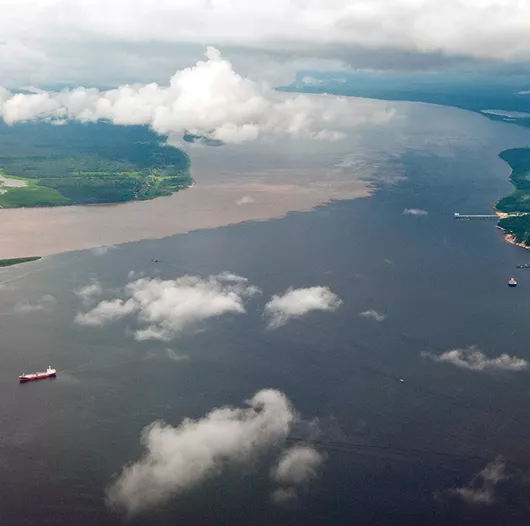The Confluent Enterprise: Where Digital and Decarbonization Meet


Just south of the equator, the Rio Solimões flows east across Brazil from the Peruvian border. A few hundred miles north in Columbia, the Rio Negro starts its diagonal journey southeast through Brazil. These two very different, very important rivers meet near the town of Manaus to form the mighty Amazon, which presses ever eastward to the South Atlantic.
The confluence of these rivers is dramatic. The dark waters of the Rio Negro flow alongside the muddy brown Rio Solimões for several miles before blending as one Amazon. In addition to being a scenic wonder, the confluence is also a boon for water life: the black water is rich with zooplankton, while the brown waters provide an abundance of fish larvae, which together produce a healthy ecosystem for fish and fishermen.
The idea of confluence and its benefits transcend easily to the enterprise and in particular to digitalization and decarbonization. Too often, I meet with companies who are sincerely focused on one or the other. But this is folly. Organizations in the 21st century, with human-induced climate change at our door, have a responsibility to blend these two very different, very important concepts throughout the business. There are numerous sustainability steps and actions that can be taken alongside digitalization journeys to reduce carbon emissions, from technical innovations and choices to process-oriented solutions. When organizations begin to blend these concepts, much like the Amazon, the effort grows easier and more natural as time goes on. And, like the Amazon, the confluent enterprise spawns benefits far greater and longer lasting than the individual efforts.
From Hitachi’s standpoint, we’re committed to achieving carbon neutrality by 2030. To achieve this it means all the Hitachi Group companies must work together and individually to take on challenging and impactful projects -- from rail transportation, the automotive industry, the energy sector to the water industry and the IT sector, for which I’m a part.
At Hitachi Vantara, we’re taking a holistic approach to the challenge and attacking carbon on multiple levels. We’re investing in decarbonizing of our offices, our factories, but also in introducing new low-carbon infrastructures to our customers. We’re developing and providing new technologies, new solutions in terms of storage and server products that are increasingly energy efficient. But like the confluent waters, these solutions are built to also increase utilization in the data center to reduce the CO2 emissions. This can lead to lower costs, as well as more agile and nimble data centers.
Indeed, decarbonization can accelerate digitalization journeys. But to do it requires choosing the right technologies and integrating them into the right architectures. Do this, and you’ll increase the value of your data by better connecting it, facilitating the enrichment of it, and gaining insights from it.
In this new world, your business needs a short, medium, and long-term plan. We like to say that to do that, you need to think about modern infrastructure that is cloud-ready, secure and easily scaled across a hybrid cloud environment. The key here is to make these three plans work together, and if you manage to do that, it can be powerful.
Move away from the old thinking of stratifying and delineating between business plans and sustainability plans. Your infrastructure and data are the single biggest assets you have. It’s time to begin managing and optimizing each sustainably. The more you do, the easier it gets. This is the modern enterprise. The confluent enterprise.
Be sure to check out Insights for perspectives on the data-driven world.
Related

Tom has +30 years' experience in data center modernization, from compute and data infrastructure to hybrid and multicloud, applications, DataOps and big data analytics. He writes extensively about technology and advocates for sustainability and social innovation.